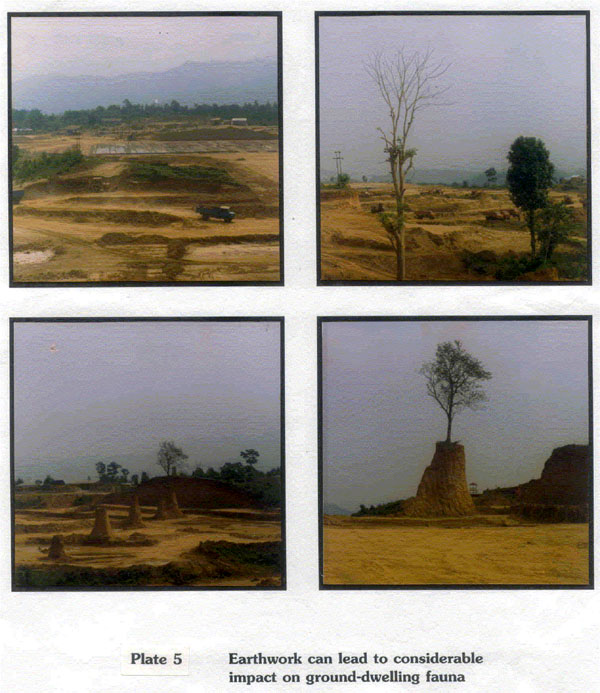Impacts of earthwork
The earthwork for site preparation involves logging, clear felling, cutting, felling, trenching, building and levelling. These are visualised as disturbances of significant magnitude. Some areas of the airport site would even require cutting to a depth of 10 to 15 meters (Plate 5).

The combined negative impacts of site preparation would manifest in the form of increased erosion, disruption of hydrological cycle, compaction of soil, loss of top soil and nutrients and declining fertility. Given the nature of terrain and topography of the area, the earthwork would induce land instability, land slips and land slides. The basic strip requirement of 300 m in width of levelled ground being reduced to 150 m width will however reduce the imbalances to a minimum.
The earthwork and other activities during the construction phase of the project are likely to eliminate some plant species. However, based on the studies conducted and the floral inventory of the area, the loss of any rare and endangered species of plants is not visualised during the construction phase of the project.
The floral species of the project area are only representing the remnant floral wealth of the region. Demand for fuel wood is already on an increase in the region. Illicit felling and smuggling of timber and exploitation of resources for industries have already resulted in dwindling number of medicinal plants, timber species and orchids. Even in a pre-project scenario, poorly stocked forests of younger age classes with low harvestable yield are leading to constantly widening gaps between sustainable supplies and resource demand. The earthwork for the proposed project is therefore not likely to lead to additional impacts on the floral wealth of the region.
With respect to the existing status of wildlife of the project area, it has already been stated in preceding section that the diversity and number of wild animals and birds commonly found in the forested regions of Aizawl have decreased considerably due to large scale destruction of wildlife habitats brought about by traditional jhumming, poaching and hunting practices. The period of study coincided with the preliminary site preparation activities including earthwork, haulage of construction material, movement of heavy machinery. This could have actually resulted in the movement of some animals into the nearest refuges prior to our undertaking wildlife surveys in the region. In absence of bench mark or baseline data with respect to animal numbers in the pre project scenario, it is difficult to predict impacts of project both on wildlife and on the terrestrial habitats in the project area. The only inferences of the generally low wildlife habitat potential of the area could be drawn from the ever increasing incidences of biotic activities that are influencing the suitability of the habitats even in a pre project scenario. The generally low wildlife habitat potential of the area is expected in the habitats already stressed on account of ever increasing biotic influences. Lack of direct and indirect evidences of animals in the project area further establish the poor habitat potential of the area for supporting significant numbers of wild animals. The magnitude of earthwork involved in the proposed project is therefore not likely to further alter the faunal status of the area.
Last Updated: January 20, 2014









